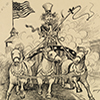
Congress Represented in Political Cartoons
Summary
In this lesson students will analyze political cartoons drawn by Clifford K. Berryman between 1898 and 1948 to learn about Congress and its constitutional role in government. The lesson is designed to accompany the free eBook Representing Congress: Clifford K. Berryman’s Political Cartoons.
Rationale
Political cartoons inform the public and spark discussion about important issues. They have been popular for centuries and continue to be influential today. While some political cartoons only made sense in their original era, others have a timeless appeal. Analyzing iconic political cartoons teaches about the institutions and issues of civic life, demonstrates unchanging aspects of American politics, and builds critical thinking skills.
Guiding Question
What can today’s citizens learn about Congress and the Constitution from studying cartoons by Clifford K. Berryman?
Materials
Recommended Grade Levels
Grades 7-12
Courses
U.S. Government; Civics
Topics included in this lesson
Political cartoons, Congress, the Constitution, political parties, representation, legislating
Featured Documents
 The Center for Legislative Archives maintains approximately 2,400 original pen-and-ink drawings by cartoonists Clifford K. Berryman and his son, Jim Berryman, in the U.S. Senate Collection.
The Center for Legislative Archives maintains approximately 2,400 original pen-and-ink drawings by cartoonists Clifford K. Berryman and his son, Jim Berryman, in the U.S. Senate Collection.
Clifford and Jim Berryman were among Washington's best-known and most-admired graphic political commentators from 1898 to 1965. Clifford K. Berryman drew for the Washington Post from 1890 until 1907, and then for the Evening Star from 1907 until his death in 1949. His son, Jim, joined the Evening Star in 1935 and drew for the paper until his retirement in 1965, winning a Pulitzer Prize in 1950. Berryman cartoons touched on a variety of subjects including politics, Presidential and congressional elections, both World Wars, and even Washington weather.
Time Required
The time needed to compete each step of this lesson is presented in parenthesis at each step. The lesson can be done as a whole or each step can be done separately.
Learning Activities
1. Introducing Political Cartoons (30 minutes)
Divide the class into six groups and distribute the Cartoon Analysis Worksheet and Worksheet 1. Assign each group a cartoon (two cartoons will be assigned to two groups). Instruct the students to complete their analysis by following the directions the worksheet contains.
2. Studying the eBook (30 minutes)
Access Representing Congress: Clifford K. Berryman’s Political Cartoons and assign each group a chapter to study. The six chapters are:
- Congress and the Constitution: Articles I and II Illustrated
- Congress: the Elected, Representative Branch of Government
- Congress: Making Laws for the Nation
- Congress and the President: Balancing Articles I and II
- The Two-Party System in Congress
- A Member’s Job: Representing the People and the States
3. Analyzing the Cartoons (30 minutes)
Distribute the Cartoon Analysis Worksheet, Worksheets 2 – 7 and caption cards so that each group has the corresponding worksheet and cards that correspond to the chapter they studied in the eBook. Instruct the students to complete their assigned worksheets by following the directions it contains. Have each group share its responses.
4. Reflection (30 minutes)
Distribute the Reflection Questions. Have each group discuss them and prepare to share their findings with the whole class. Have each group share its responses.
Note: A large version of each cartoon is available online via the National Archives Catalog. To access these versions, simply type the catalog number found below each image into the search box.
Additional Political Cartoons Resources:
Congress Represented in Political Cartoons
Constitution Scavenger Hunt with Political Cartoons
Reviewing Big Civics Ideas through Political Cartoons
Find more Berryman cartoons in the Center for Legislative Archives in the exhibit "Running for Office."
If you have problems viewing this page, please contact legislative.archives@nara.gov.